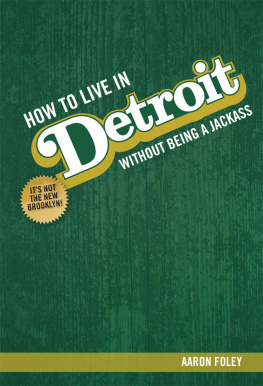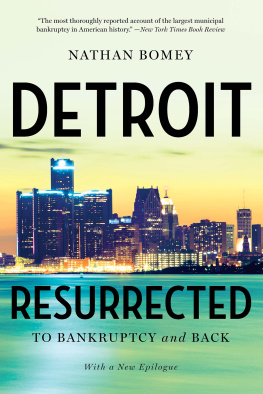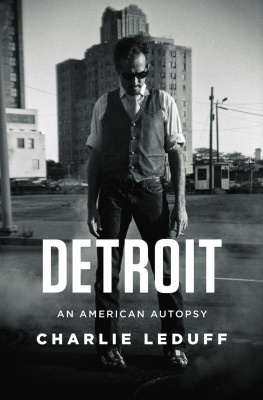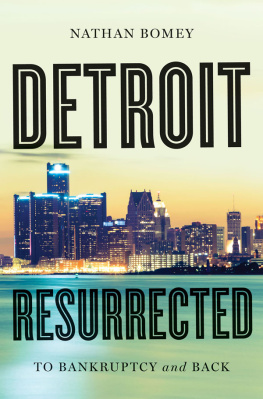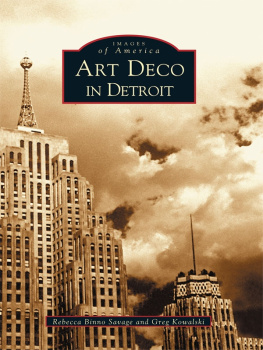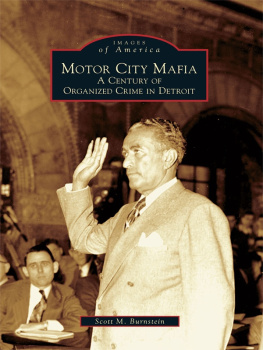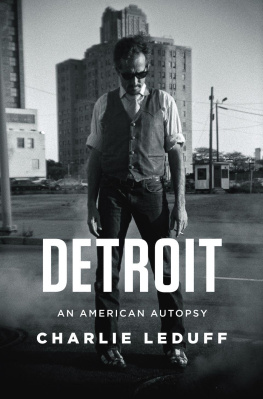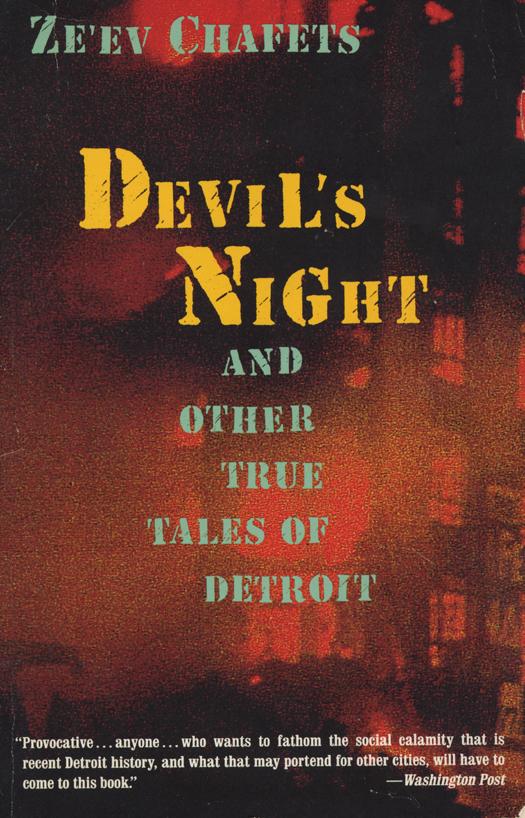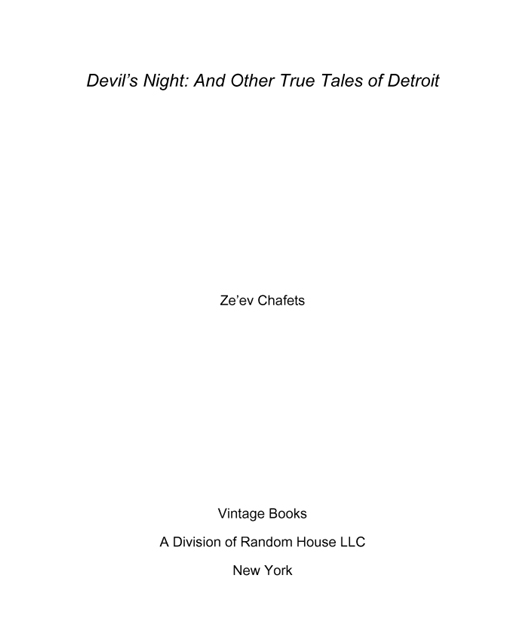FIRST VINTAGE EBOOKS EDITION, OCTOBER 1991
Copyright 1990 by Zeev Chafets
All rights reserved. Published in the United States by Vintage Books, a division of Random House LLC, a Penguin Random House Company, New York, and in Canada by Random House of Canada Limited, Toronto. Originally published in hardcover by Random House, New York, in 1990.
Vintage and colophon are trademarks of Random House LLC.
Grateful acknowledgment is made to the following for permission to reprint previously published material:
THE DETROIT NEWS: Excerpts from a column by Chuck Moss, September 20, 1989; excerpts from an interview between the editorial board of The Detroit News and Mayor Young, October 19, 1989; excerpts from an article by Chauncey Bailey, November 11, 1989. Copyright 1989 The Detroit News. Reprinted by permission of The Detroit News, a Gannett Newspaper.
JOBETE MUSIC CO., INC.: Excerpt from Dancing in the Street by Marvin Gaye, William Stevenson, and Ivy Hunter. Copyright 1964 Jobete Music Co., Inc., and Stone Agate Music. Published by Jobete Music Co., Inc./Stone Agate Music. Reprinted by permission.
DUDLEY RANDALL: Excerpt from Detroit Renaissance from A Litany o Friends by Dudley Randall. Copyright 1981 by Dudley Randall. Reprinted by permission of Dudley Randall.
THE RICHMOND ORGANIZATION: Excerpt from We Shall Overcome by Zilphia Horton, Frank Hamilton, Guy Carawan, and Pete Seeger. Copyright 1960 (renewed) by The Richmond Organization. Copyright 1963 by Ludlow Music, Inc., New York, NY. Reprinted by permission.
eISBN: 978-0-8041-7141-0
Cover photograph by Thierry Campion/Sygma
Cover design by David Tran
www.vintagebooks.com
v3.1
FOR KIM WESTON, WHO WANTS TO SAVE THE WORLD .
Personal Note

This book was written in Detroit, where I lived during the last half of 1988 and, again, for several months of 1989. It is a personal account, based on people I met, things I saw and events in which I participated.
During the course of my stay in Detroit, I interviewed hundreds of people. In most cases it was impractical to use a tape recorder. I took notes or, on some occasions, reconstructed conversations from memory. Thus, the quotes in this book are not, for the most part, stenographic reproductions; some have been edited for length, others are close approximations. In every case, however, they are accurate reflections of what people actually said.
This book could not have been written without the help of a great many people. Foremost among them are two good friends: Arthur Samuelson, who provided encouragement and expert advice at a critical juncture, and Gary Baumgarten, one of Americas finest reporters, who gave me my first lessons on the city of Detroit. I would also like to thank Joseph Colten, Doug Ross, Beatrice Buck, Bob Berg, Chauncey Bailey, David Lawrence, Max Silk, Gary Miller, Cassandra Smith-Gray, Gerald Clark, Fred Williams, Dave Scott, Doron Levine, Steve Franklin, Sue Smock, Irving Bluestone, Nimrod Rosenthal, Bill McGraw, Linda Jones and Janis Goldstein for their generous assistance. I would also like to thank the many Detroiters and suburbanites who shared their insights about their city and their lives. All of them made a contribution to my understanding of Detroit, but, naturally, none is responsible for the finished product.
I want to thank my agent, Esther Newberg of ICM, who helped save this project at a very difficult juncture. And I particularly want to thank David Rosenthal, my editor at Random House, who believed in this book and made it possible.
Contents


Introduction: DEVILS NIGHT
DEVILS NIGHT 
It was in the fall of 1986 that I first saw the devil on the streets of Detroit.
We were introduced by a friend who works for a local radio station. Spend the evening before Halloween with me and Ill show you something youve never seen before, he promised. People try to burn down their own neighborhoods. They call it Devils Night.
I vaguely remembered Devils Night. When I was a kid growing up in Pontiac, a grimy industrial clone of Detroit ten miles north of the city, it had been a time of harmless prankswindow soaping, doorbell ringing and rolls of toilet paper in the neighbors trees. But it had been twenty years since I lived there, and a lot of things had changed. One of them was Devils Night.
Three years earlier, in 1983, for reasons no one understands, Americas sixth largest city suddenly erupted into flame. Houses, abandoned buildings, even unused factories burned to the ground in an orgy of arson that lasted for seventy-two hours. When it was over the papers reported more than eight hundred fires. Smoke hung over the city for days.
What at first appeared to be a bizarre outburst turned into an annual tradition. By 1986, Devils Night had become a prelude to Halloween in Detroit in the way that Mardi Gras precedes Lent in New Orleans, or the Rose Bowl parade ushers in the New Year in Pasadena.
Even my friends dramatic description did not prepare me for what I saw that night. From early evening, fires flared throughout the city. The scent of burning wood in the crisp Michigan autumn evening filled me with an incongruous nostalgia for the homecoming rallies I once attended at the University of Michigan. On the streets of Detroit I could sense the same rush of energy, the same sense of excitement that always accompanies nocturnal action. Police helicopters circled overhead and fire trucks, sirens blaring, raced from one conflagration to another. Cops guarded the firemen as they fought the flames. It was only when I saw the faces of the neighborhood people, mostly older blacks with long coats over their bathrobes, standing grimly on their porches, armed with shotguns and garden hoses, protecting their property, that I realized that this was no homecoming rally; on Devils Night, they use homes for kindling.
At each fire there were crowds of onlookers. Some were black neighborhood kids in stocking caps and high school jackets. Others were white adultsprofessional fire fighters from surrounding townships on a busmans holiday and civilian thrill seekers from the suburbs, many of them on their one annual trip into the city. The crowds were augmented by people who had come from all over the United States, Europe and the Far East to participate in Devils Night, the fire buffs Superbowl.


